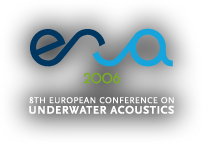

J.C. Legac (1) legac@nurc.nato.int
J.-P. Hermand (2) jhermand@ulb.ac.be
S.M. Jesus (3) sjesus@ualg.pt
(1) NATO Undersea Research Centre, Viale San Bartolomeu 400, 19138, La Spezia, Italy
(2) Environmental Hydroacoustics Lab, Department of Optics and Acoustics
Université Libre de Bruxelles, av. Franklin D. Roosevelt 50 - CP 194/05, B-1050 Bruxelles,
Belgium
(3)ISR, Universidade do Algarve, Campus de Gambelas, PT-8005-139 Faro, Portugal.
Ref.: invited to Acoustics'08, Paris, France, June 2008.
Abstract
In order to evaluate properly the acoustic propagation characteristics in shallow water environments,
it is well established that appropriate knowledge of the acoustic properties of the seabottom is
required. In the last decade, full-field geoacoustic inversion techniques have been demonstrated
to provide adequate methodologies to assess those properties. However, several of the developed
techniques may suffer a lack of adequacy to the design of low-frequency active sonar systems (LFAS)
for which the assessment of seabottom characteristics are drawn. For instance most matched-field
inversion techniques demonstrated so far use acoustical signals at much lower frequencies than those
of the sonar (few tens to hundreds Hertz to be compared to the 1-2 kHz range of standard LFAS).
Furthermore, some of the techniques may be difficult to be handled in an “operationally relevant
context” since they are based on relatively complex designed systems such as highly instrumented
vertical line arrays spanning the whole water column. In this paper, we investigate the potentialities
of medium frequency acoustical signals (800-1600 Hz) received at several ranges (from 1 km to 10 km)
along a field of drifting sparse arrays eventually reduced to a couple of hydrophones or even a
single one for spatial coherent geoacoustic inversion purposes. The experimental datasets of the
Maritime Rapid Environmental Assessment BP’07 seatrials South of Elba Island in the Mediterranean
Sea are used to support this study.